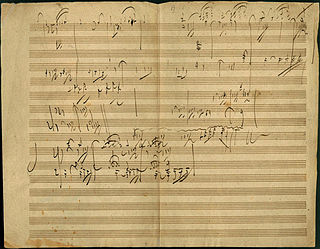Related Research Articles

Paul Badura-Skoda was an Austrian pianist.

Franz Schubert wrote his Sonata in C major for piano four-hands, D 812, in June 1824 during his second stay at the Esterházy estate in Zseliz. The extended work, in four movements, has a performance time of around 40 to 45 minutes. It was published as Grand Duo, Op. 140, in 1837, nine years after the composer's death.
The Piano Sonata in A minor D. 845 (Op.42) by Franz Schubert is a sonata for solo piano. Composed in May 1825 and entitled Premiere Grande Sonata, it is the first of three sonatas published during the composer's lifetime, the others being D.850 and D.894. Conceived as a set, these works were composed during what was reportedly a period of relatively good health and spirits for Schubert, and are praised for their quality and ambition. This first sonata in particular marks a significant step toward the composer’s mature piano sonata style; the format and several characteristic stylistic elements continue through the last.
Franz Schubert's Piano Sonata in C major, D. 840, nicknamed "Reliquie" upon its first publication in 1861 in the mistaken belief that it had been Schubert's last work, was written in April 1825, whilst the composer was also working on the A minor sonata, D. 845 in tandem. Schubert abandoned the C major sonata, and only the first two movements were fully completed, with the trio section of the third movement also written in full. The minuet section of the third movement is incomplete and contains unusual harmonic changes, which suggests it was there Schubert had become disillusioned and abandoned the movement and later the sonata. The final fourth movement is also incomplete, ending abruptly after 272 measures.
Franz Schubert's Piano Sonata in A-flat major D 557 was composed in May 1817.
The Piano Sonata in F-sharp minor D 571, was composed by Franz Schubert in July 1817. The sonata was first published long after the composer's death in 1888 by Breitkopf & Härtel.

Franz Schubert's last three piano sonatas, D 958, 959 and 960, are his last major compositions for solo piano. They were written during the last months of his life, between the spring and autumn of 1828, but were not published until about ten years after his death, in 1838–39. Like the rest of Schubert's piano sonatas, they were mostly neglected in the 19th century. By the late 20th century, however, public and critical opinion had changed, and these sonatas are now considered among the most important of the composer's mature masterpieces. They are part of the core piano repertoire, appearing regularly on concert programs and recordings.
The Piano Sonata in E minor D 566 by Franz Schubert is a sonata for solo piano written in June 1817. The original manuscript appeared to lack a finale. Ludwig Scheibler (1848-1921) was the first to suggest in 1905 that the Rondo in E, D.506 might be that movement. The British composer and musicologist Kathleen Dale produced the first edition using this suggestion in 1948. The 1976 Henle edition by Paul Badura-Skoda followed the same practice.
The Piano Sonata in E major, D 157 is a piano sonata with three movements composed by Franz Schubert in February 1815. The Allegro D 154 is an early version of its first movement.
The Piano Sonata in C major, D 279, composed by Franz Schubert in September 1815, has three movements and is regarded as incomplete for lacking a fourth movement. D. 346, an unfinished Allegretto in C major, has been suggested as its final movement.
The Piano Sonata in F minor D 625 is a piano sonata written in September 1818 by Franz Schubert. The Adagio D. 505 is assumed to be its slow movement.
Sonatas, duos and fantasies by Franz Schubert include all works for solo piano by Franz Schubert, except separate dances. They also include a number of works for two players: piano four hands, or piano and a string instrument.

In music, a sketch is an informal document prepared by a composer to assist in the process of composition.
References
Notes
- 1 2 3 Wigmore 2001 , p. 5
- 1 2 Johnston 2016
- ↑ Anderson 1999
- ↑ Cooper 2008, p. 118.
- 1 2 Badura-Skoda 2008 , p. 277
Sources
- Anderson, Keith (1989). Schubert: Piano Trios in B-Flat major, D. 898 and D. 28 (CD). Naxos Records. 8.550131.
- Badura-Skoda, Eva (2008). "The Chronology of Schubert's Piano Trios". In Badura-Skoda, Eva; Branscombe, Peter (eds.). Schubert Studies: Problems of Style and Chronology. Cambridge: Cambridge University Press.
- Cooper, Barry (2008). "Composers Born between 1700 and 1800". Child Composers and Their Works: A Historical Survey. Lanham: Scarecrow Press.
- Johnston, Blair (2016). "Piano Trio in B flat major ("Sonatensatz"), D.28". AllMusic . Retrieved 2016-09-19.
- Wigmore, Richard (2001). Schubert: Piano Trios D898, D28 & D897 (PDF) (CD). Hyperion Records. CDA67273.